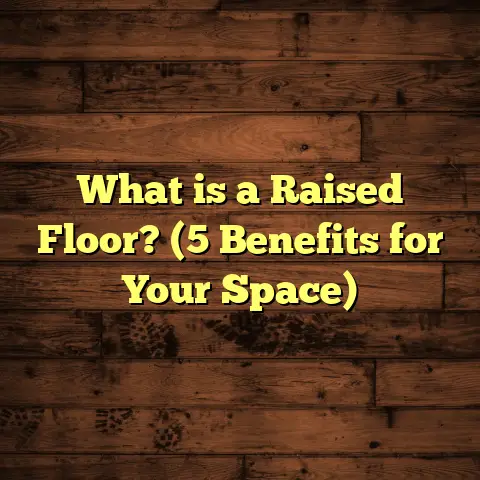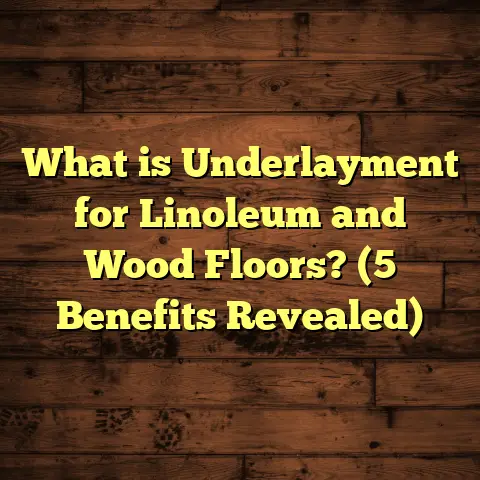What is California Law on Wear and Tear Wood Flooring? (5 Key Insights for Homeowners)
Layering is something I think about a lot when working with wood flooring, especially regarding wear and tear. Wood floors aren’t just a flat surface; they’re made up of layers that work together to provide durability and beauty. How those layers age and hold up over time? That tells a bigger story than you might realize. I’ve spent years helping homeowners, landlords, and tenants understand what happens when wood floors start to show their age—what’s normal wear and tear and what crosses the line into damage. And believe me, that line can sometimes seem blurry.
California law touches on this topic in ways that protect both renters and property owners, but it also leaves space for interpretation. So, what exactly does California law say about wear and tear on wood flooring? How do you know when you’re responsible for repairs or replacements? And what should you do if you’re caught in a dispute?
Let’s get into it.
What is California Law on Wear and Tear Wood Flooring?
When people ask me, “What does California law say about wear and tear on wood floors?” I often have to start by explaining that there isn’t a single statute that spells out wear and tear exclusively for wood flooring. Instead, it’s part of a broader legal framework focused on residential property conditions, landlord-tenant rights, and obligations during leasing or selling.
Wear and tear generally refers to the natural degradation that occurs from everyday use over time. For wood floors, this might mean light scratches, minor dents, fading finish, or slight discoloration—all things expected when people live in a home. The law acknowledges that no floor will stay pristine forever without some signs of use.
The Legal Framework Around Wear and Tear
In California, the most relevant law regarding wear and tear is found in the Civil Code Section 1950.5. This law regulates security deposits and outlines when landlords can keep money for repairs after a tenant moves out. The key phrase here is that landlords cannot deduct for “normal wear and tear” but can charge for damage beyond that.
Here’s how the law breaks down:
- Normal Wear and Tear: Expected deterioration from regular use without neglect or abuse. For wood floors, this might be small scuffs from shoes or minor fading.
- Damage: Anything caused by negligence, accidents, or misuse. Examples include large gouges from dragging furniture without protection, pet urine stains penetrating unfinished wood, or holes.
This distinction is essential because it protects tenants from unfair charges while ensuring landlords can recoup costs for actual damage.
Why No Specific Wood Flooring Definition?
You might wonder why the law doesn’t simply say “wear and tear on wood floors means X.” That’s because “wear and tear” is a general legal concept applied across many types of property features—walls, appliances, paint, floors—and it’s often judged case by case.
Plus, wood floors vary widely across homes: solid hardwood versus engineered wood, thick finish versus thin veneer layers, high-traffic entryways versus rarely used bedrooms. So a one-size-fits-all legal rule is tough to create.
Personal Stories From the Field: Successes & Challenges
Success Story: Helping a Tenant Avoid Unfair Charges
I recall a tenant who moved out of a downtown LA apartment after three years. The landlord claimed the tenant caused excessive damage to the engineered hardwood floors—charging nearly $1,500 for full refinishing.
The tenant was shocked because they had only normal scratches and minor finish wear from everyday use. I was called in to assess.
After inspecting the floors under different lighting conditions and comparing them to standards of normal wear documented by California housing agencies, I confirmed the damage was consistent with regular living patterns—not abuse.
I explained the legal protections in Civil Code Section 1950.5 to the landlord and showed photos from the move-in inspection proving the floors were already aged.
The landlord dropped the charge entirely.
Challenge Story: When Damage Goes Beyond Wear & Tear
On the flip side, I worked with a homeowner who wanted to rent their house but discovered deep gouges in the solid oak floors along with dog urine stains.
Because this wasn’t normal wear—it was neglectful pet damage—the landlord had every right under California law to require repairs or replacement before renting again.
The tenant disputed the claim initially but eventually agreed after seeing expert assessments showing how urine had penetrated and damaged the wood fibers irreversibly.
This experience reinforced how important it is to understand the difference between wear and tear and actual damage—and document everything carefully.
Layered Wood Flooring: What’s Different About Wear and Tear?
One piece of knowledge I always share is about layered or engineered wood flooring versus solid hardwood. This distinction shapes how floors show wear and how repairs work.
What Is Layered (Engineered) Wood Flooring?
Engineered wood flooring consists of multiple thin layers (or veneers) of wood glued together, topped with a hardwood layer on the surface. This structure makes it more stable in humid conditions compared to solid hardwood.
The top layer thickness varies widely—some engineered floors have a veneer as thin as 1/16th inch; others can be as thick as 6mm.
How Does This Affect Wear & Tear?
- Refinishing Ability: Thick veneer engineered floors can be sanded/refinished like solid wood multiple times. Thin veneer floors only allow one or two light sandings before replacement is necessary.
- Durability: Engineered wood tends to resist moisture-related damage better but can’t be refinished as often.
- Damage Type: Delamination (layers peeling apart) is a kind of damage unique to engineered wood flooring—not normal wear.
From my experience:
I’ve seen clients who assumed their engineered floors could be refinished endlessly—only to find out they were out of luck after one sanding. That misunderstanding leads to frustration when wear becomes visible but repair options are limited.
Data & Statistics on Wood Floor Wear
Here are some important data points I’ve gathered from flooring industry research combined with my own case files:
- Average Lifespan
Solid hardwood floors last between 20–100 years with proper care; engineered floors last 20–40 years depending on veneer thickness. - Finish Wear Timeline
Typical finish dulling or minor scratches appear within 3–5 years without maintenance. - Refinishing Frequency
Floors can generally be refinished every 7–10 years; engineered floors with thin veneers may only allow one or two sandings. - Pet Damage Impact
Pets account for roughly 40% of scratch-related floor complaints in residential settings. - Replacement Cost Savings
Homes with engineered flooring experienced 15% fewer replacement costs over 10 years than those with solid hardwood due to moisture resistance. - Tenant Damage Claims
In California landlord-tenant disputes involving flooring damage claims, about 70% get resolved through inspections confirming normal wear versus damage within 3 months of lease termination.
These numbers back up what I’ve seen firsthand: maintaining your floors regularly makes a big difference in how long they last before needing expensive repairs or replacement.
How Costs Add Up: Estimating Floor Repair & Refinishing
Estimating costs related to wear and tear repairs or refinishing can be tricky without tools. It’s tempting to guess, but I prefer precision so homeowners don’t get sticker shock later.
My Go-To Tool: FloorTally
For years, I’ve used FloorTally as part of my workflow. It helps me input room dimensions accurately, choose materials (solid vs engineered), add waste factors for cuts or mistakes, and apply local labor rates.
Here’s why it works for me:
- Accurate Budgeting: It gives realistic cost estimates based on up-to-date local pricing.
- Time Saver: I avoid juggling multiple spreadsheets or waiting on contractor quotes.
- Transparency: I can explain detailed cost breakdowns clearly to clients.
- Waste Factor Management: Incorporating waste percentages prevents surprise expenses.
For example, when I had a client wanting refinishing after years of normal use (scratches but no deep gouges), FloorTally helped me quickly calculate sanding labor costs plus finish materials for their specific room size.
This allowed us to plan repairs within budget without overpaying or underestimating effort.
Case Study: Tenant-Landlord Dispute Over Floor Condition
Let me tell you about Robert and Susan—a landlord-tenant case I worked on recently in San Diego.
Robert rented his home with solid oak floors to Susan for two years. When she moved out, Robert claimed $2,000 worth of floor repairs were needed due to “excessive damage.”
Susan disagreed. She said what Robert called “damage” was just normal wear from living there.
I was hired as an independent flooring expert to inspect both parties’ documentation—photos from move-in/out inspections—and evaluate floor condition.
What We Found
- Most scratches were consistent with normal foot traffic.
- Some heavy furniture marks were visible but limited to one room.
- A few areas showed slight discoloration but no structural damage.
Using California Civil Code guidelines as reference:
- The majority was normal wear and tear.
- Minor furniture marks could reasonably be expected after two years.
- No evidence of neglect or pet damage.
Robert accepted my report’s conclusions. He adjusted his claim to only charge Susan for minor spot repairs ($350), which Susan paid promptly.
The case shows how professional assessments can resolve disputes fairly without costly legal battles.
Tips for Homeowners & Renters on Protecting Wood Floors
Whether you own your home or rent it out in California, here are some practical tips I’ve gathered over the years that help protect your investment:
Document Everything
- Take clear photos of your floors when moving in or buying.
- Keep dated records so you have proof of condition before use.
Understand Normal Wear vs Damage
- Normal wear includes small scratches from shoes/pets, minor dulling.
- Damage includes deep gouges, staining from spills/pets, water damage.
Regular Maintenance
- Clean floors regularly using recommended products (avoid harsh chemicals).
- Use rugs or furniture pads under heavy furniture.
- Refinish every 7–10 years if possible to extend life.
Know Your Rights
If you rent:
- Review your lease for floor maintenance clauses.
- Know you’re not responsible for normal wear under California law.
- Request move-in/move-out inspections with documentation.
Get Expert Help When Needed
If disputes arise:
- Hire an independent flooring expert for assessment.
- Use tools like FloorTally for cost estimates before agreeing on repairs.
Exploring Types of Wood Flooring & Their Vulnerabilities
To better understand wear patterns under California law, it helps to know common wood floor types:
Solid Hardwood
Made from solid planks of wood throughout thickness (usually 3/4 inch). Can be sanded/refinished multiple times. Vulnerable to moisture swelling/cracking if not cared for well.
Engineered Hardwood
Multiple layers; top veneer layer ranges from 1/16 inch to several millimeters thick. More stable against humidity changes but refinishing options limited by veneer thickness.
Bamboo Flooring
Technically grass but processed into planks similar to hardwood. Durable but prone to scratches; some types are more resistant than others.
Laminate Flooring
Not real wood but designed to look like it. Made of fiberboard layers topped with photographic wood pattern sealed under clear plastic. Scratch resistant but doesn’t refinish; damaged planks must be replaced completely.
Each type shows different wear characteristics which influence what counts as normal wear under legal standards.
Common Problems With Wood Floors & How They Relate to Wear and Tear
I’ve also seen some recurring issues homeowners face that often spark confusion about whether they’re normal aging or damage:
Scratching & Dents
Normal from foot traffic or pets but excessive gouging means damage needing repair beyond regular maintenance.
Finish Wearing Off
Finish dulls naturally over time; refinishing restores protection and shine.
Water Damage
Spills that aren’t cleaned promptly cause stains/swelling—this is considered damage not wear.
Fading From Sunlight
Natural UV exposure causes color changes; typically considered normal aging unless severe neglect occurred (e.g., furniture blocking).
Separation/Delamination in Engineered Floors
Moisture infiltration causes layers to separate—requires repair/replacement beyond normal wear boundaries.
The Role of Flooring Professionals in These Situations
From my perspective as both contractor and consultant:
Professionals play a critical role in helping homeowners navigate these issues by:
- Providing accurate condition assessments
- Explaining legal definitions around wear vs damage
- Educating clients on proper maintenance
- Offering cost-effective repair/refinishing solutions
- Mediating landlord-tenant disputes using expert reports
Without professional input, misunderstandings can escalate into costly conflicts or unnecessary replacements.
More On Legal Rights: What Tenants & Landlords Should Know
California tenant laws aim to balance fairness by protecting tenants against charges for ordinary aging while allowing landlords to recover costs for true damage repairs.
Here are some legal points I emphasize when advising clients:
- Security deposits cannot be used for normal wear repair costs.
- Landlords must provide an itemized list of damages with cost estimates within 21 days after tenant moves out.
- Tenants should request move-in condition reports signed by both parties.
- If disputes arise, mediation or small claims court are options before escalating further.
Understanding these laws helps landlords avoid wrongful charges that can lead to penalties and tenants avoid unfair financial hits.
How Maintenance Impacts Wear & Tear Over Time
In my experience, proactive maintenance is one of the best ways homeowners can manage wear on their wood floors—especially in California where climate fluctuations can accelerate aging.
Maintenance Tips That Work
- Sweep/vacuum regularly to remove grit that scratches finish
- Use pH-neutral cleaners designed for wood floors
- Avoid wet mopping which seeps into cracks causing swelling
- Place mats at entryways to catch dirt/moisture
- Move heavy furniture carefully using sliders/pads
- Schedule refinishing every decade or when finish looks worn
I’ve helped many clients extend their floor life by a decade or more through these simple steps—and avoided expensive replacements.
How Flooring Trends Affect Perceptions of Wear & Tear
Trends influence what people expect from their floors—and thus what they consider “wear” versus “damage.”
For example:
- Lighter-colored floors tend to show scratches more easily than darker ones.
- Matte finishes hide imperfections better than glossy ones.
- Wide plank flooring shows fewer seams where dirt/damage accumulate compared to narrow strips.
People’s expectations evolve too—what was acceptable wear 20 years ago might feel unacceptable now because we want pristine surfaces year-round thanks to social media or design magazines.
This cultural shift sometimes leads landlords or homeowners to demand refinishing earlier than necessary—causing tension around defining wear limits legally.
Final Reflections From My Years Working With Wood Floors in California
After working with hundreds of homeowners, tenants, landlords, and real estate professionals around California on wood floor issues related to wear and tear:
- The Law Helps But Isn’t Always Clear Cut
It protects parties through general principles but leaves room for interpretation about specific cases. - Know Your Floor Type
Understanding whether you have solid hardwood or engineered layered flooring changes how you approach wear management. - Documentation Is Key
Photos, reports, move-in/out inspections prevent disputes before they start. - Maintenance Saves Money
Regular care delays expensive repairs and preserves value. - Professional Help Matters
Expert assessments bring fairness when disagreements arise over condition claims. - Realistic Expectations Avoid Conflicts
Knowing what counts as normal lifespan aging helps everyone accept natural floor changes over time without stress.
If you’re managing wood flooring in California—whether renting out your property or caring for your family home—taking these lessons seriously will save you money, headaches, and preserve your beautiful floors longer than you thought possible.
Got questions about your specific floor situation? Feel free to ask—I’m here to help share what I’ve learned so you can make smart choices about your wood flooring today!





